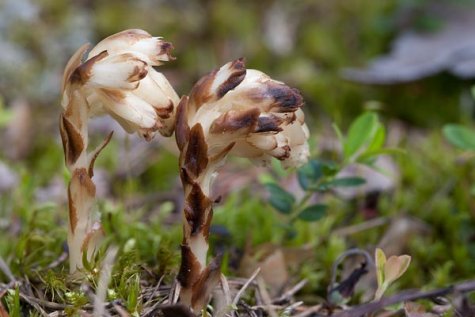Fungus and flower
Photo: Arne Ader
Translation: Liis
Dutchman's pipe
Dutchman's pipe; Yellow bird's-nest Seenlill Monotropa hypopitys
The Dutchman’s pipe is in fact a herbaceous plant but it lacks chlorophyll, and so of course also green colour. The plant’s stem as well as the scale-like leaves are soft and remind rather of “mushroom flesh”. And the life of the Dutchman’s pipe is tied to fungi. The lack of the green colour common to plants suggests that the Dutchman’s pipe cannot produce sugars itself and must get food prepared by other plants. Here the aid from the mushroom mycelium appears - the Dutchman’s pipe has a rhizome that is densely interwoven with fungal mycelium in the soil: the fungi obtain the necessary nutrients for the Dutchman’s pipe. But mushrooms are not able to produce sugars on their own either, they parasitize on plants and the Dutchman’s pipe in turn feeds from the mushrooms. From whom will the necessary nutrients be taken? From the root system of large trees: to them the fungal mycelium and the feeding of the Dutchman’s pipe doesn’t make much difference. Rather the fungal mycelium is useful for the tree roots, in its turn making it easier for the roots to get at the water in the soil and the minerals dissolved in it. The partnership is positive since all parts win by it.
The first Dutchman’s pipes were seen a few weeks ago, but they won’t be going away even in late autumn. In places this year’s plants can be seen together with the mummified stems of last year’s Dutchman’s pipes with the characteristic seed pods.
We can find it in spruce as well as pine stands, and in sand or pebble grounds without trees.









